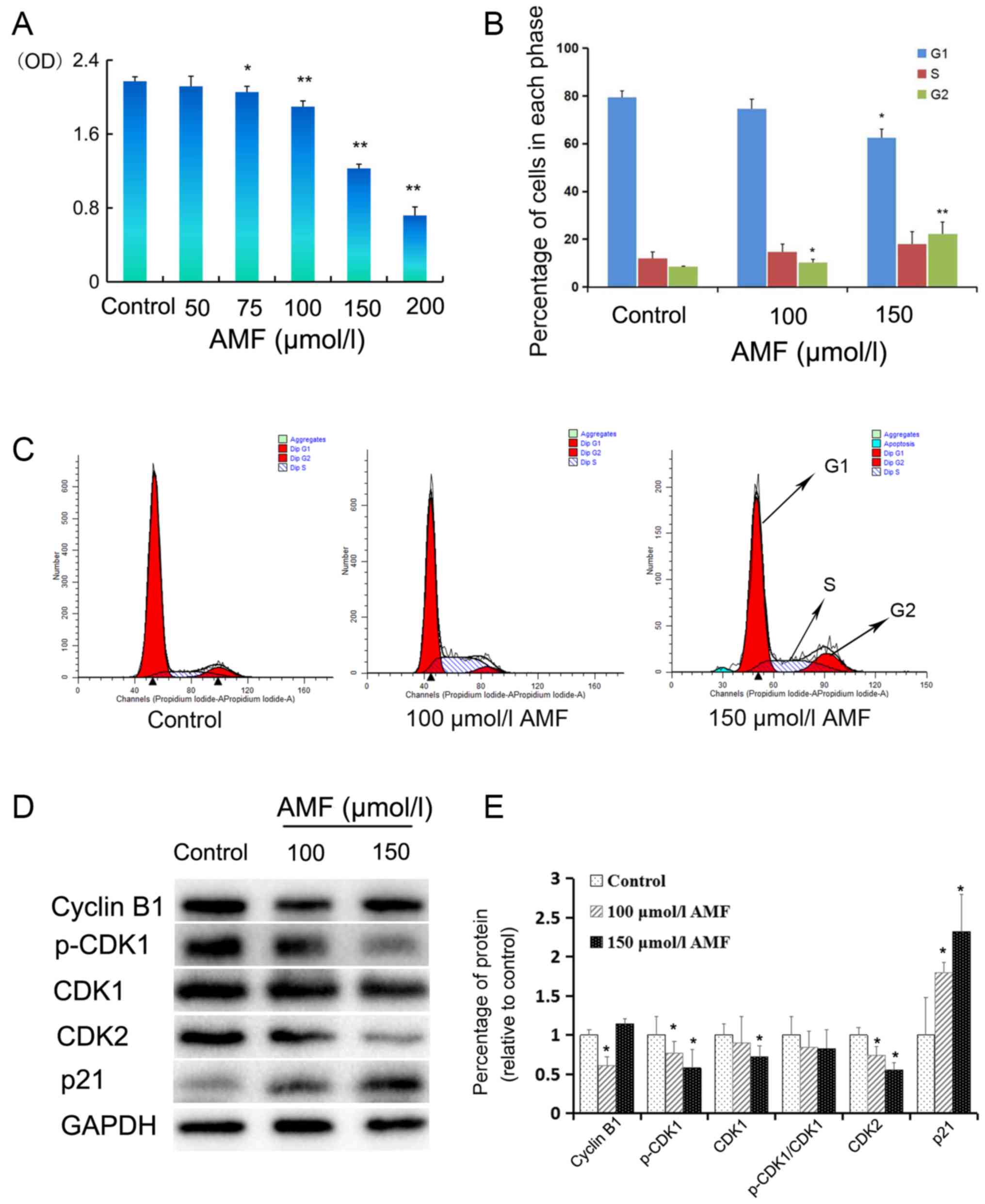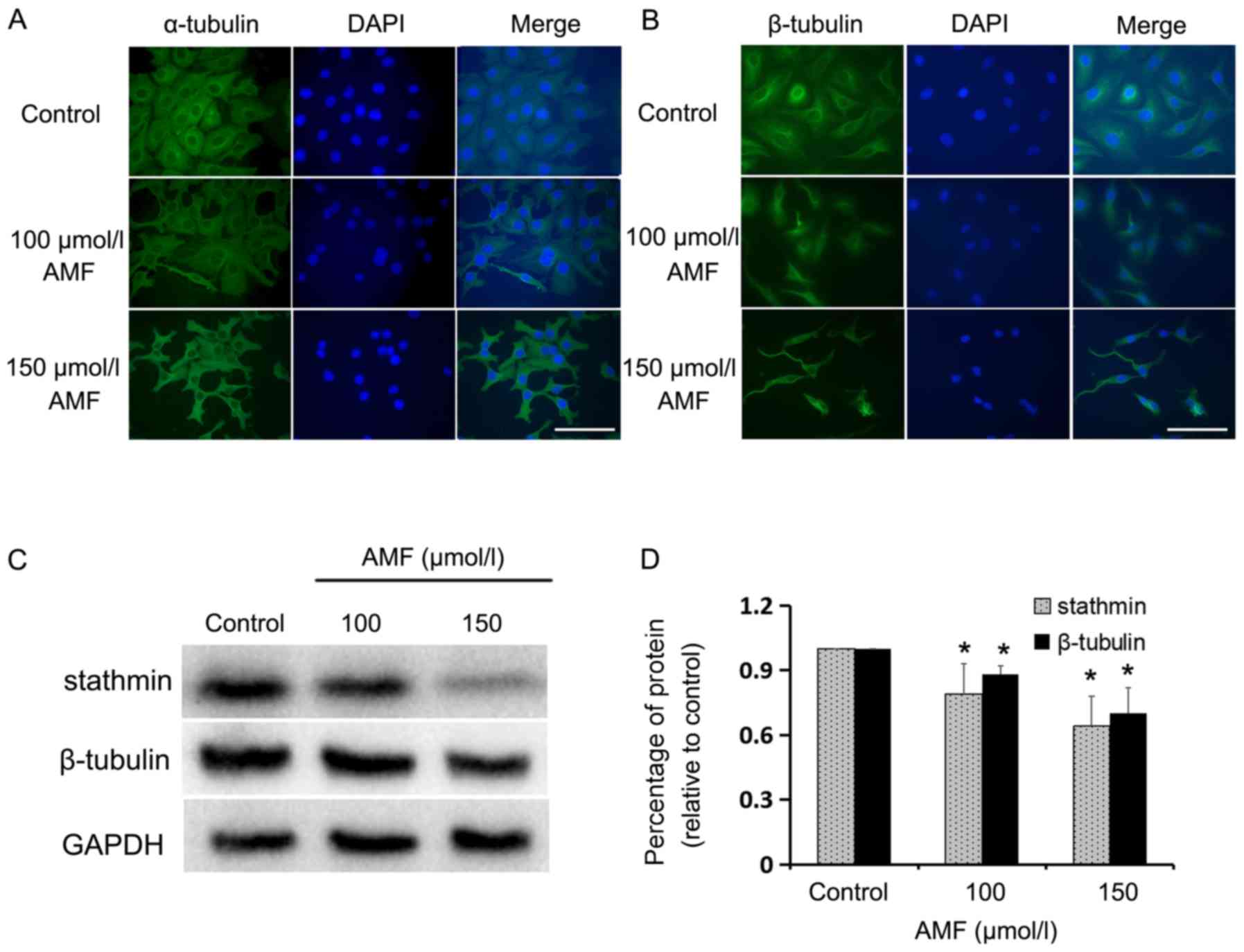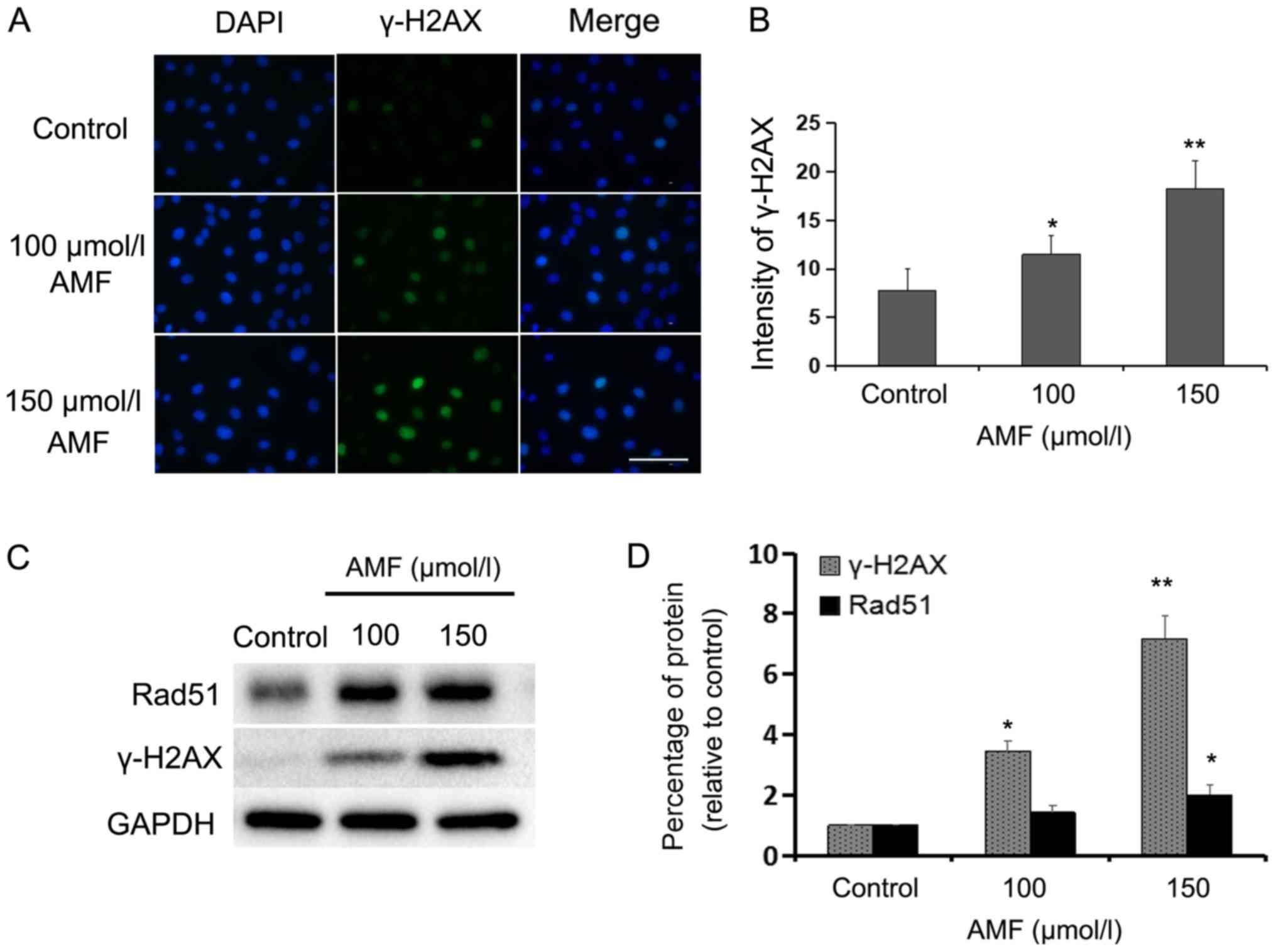|
1
|
Bray F, Ferlay J, Soerjomataram I, Siegel
RL, Torre LA and Jemal A: Global cancer statistics 2018: Globocan
estimates of incidence and mortality worldwide for 36 cancers in
185 countries. CA Cancer J Clin. 68:394–424. 2018. View Article : Google Scholar : PubMed/NCBI
|
|
2
|
Bookman MA: Optimal primary therapy of
ovarian cancer. Ann Oncol. 27 (Suppl 1):i58–i62. 2016. View Article : Google Scholar : PubMed/NCBI
|
|
3
|
Zhang X, Xu B, Sun CY, Wang LM and Miao X:
Knockdown of CIP2A sensitizes ovarian cancer cells to cisplatin: An
in vitro study. Int J Clin Exp Med. 8:16941–16947. 2015.PubMed/NCBI
|
|
4
|
Damia G and Broggini M: Platinum
resistance in ovarian cancer: Role of DNA repair. Cancers (Basel).
11:1192019. View Article : Google Scholar
|
|
5
|
Dia-Moralli S, Tarrado-Castellarnau M,
Miranda A and Cascante M: Targeting cell cycle regulation in cancer
therapy. Pharmacol Ther. 138:255–271. 2013. View Article : Google Scholar : PubMed/NCBI
|
|
6
|
Lim S and Kaldis P: Cdks, cyclins and
CKIs: Roles beyond cell cycle regulation. Development.
140:3079–3093. 2013. View Article : Google Scholar : PubMed/NCBI
|
|
7
|
Morgan DO: The cell cycle: Principles of
control. Primers in biology, New Science. 2007.
|
|
8
|
Karimian A, Ahmadi Y and Yousefi B:
Multiple functions of p21 in cell cycle, apoptosis and
transcriptional regulation after DNA damage. DNA Repair (Amst).
42:63–71. 2016. View Article : Google Scholar : PubMed/NCBI
|
|
9
|
Liebmann J, Cook JA, Lipschultz C, Teague
D, Fisher J and Mitchell JB: The influence of Cremophor EL on the
cell cycle effects of paclitaxcl (Taxol) in human tumor cell lines.
Cancer Chemother Pharmacol. 33:331–339. 1994. View Article : Google Scholar : PubMed/NCBI
|
|
10
|
Jordan MA, Toso RJ, Thrower D and Wilson
L: Mechanism of milotic block and inhibition of cell proliferation
by taxol at low concentrations. Proc Nati Acad Sci USA.
90:9552–9556. 1993. View Article : Google Scholar
|
|
11
|
Desai A and Mitchison TJ: Microtubule
polymerization dynamics. Annu Rev Cell Dev Biol. 13:83–117. 1997.
View Article : Google Scholar : PubMed/NCBI
|
|
12
|
Schiff PB, Fant J and Horwitz SB:
Promotion of microtubule assembly in vitro by taxol. Nature.
277:665–667. 1979. View
Article : Google Scholar : PubMed/NCBI
|
|
13
|
Charbaut E, Curmi PA, Ozon S, Lachkar S,
Redeker V and Sobel A: Stathmin family proteins display specific
molecular and tubulin binding properties. J Biol Chem.
276:16146–16154. 2001. View Article : Google Scholar : PubMed/NCBI
|
|
14
|
Su D, Smith SM, Preti M, Schwartz P,
Rutherford TJ, Menato G, Danese S, Ma S, Yu H and Katsaros D:
Stathmin and tubulin expression and survival of ovarian cancer
patients receiving platinum treatment with and without paclitaxel.
Cancer. 115:2453–2463. 2009. View Article : Google Scholar : PubMed/NCBI
|
|
15
|
Watanabe A, Suzuki H, Yokobori T,
Tsukagoshi M, Altan B, Kubo N, Suzuki S, Araki K, Wada S,
Kashiwabara K, et al: Stathmin1 regulates p27 expression,
proliferation and drug resistance, resulting in poor clinical
prognosis in cholangiocarcinoma. Cancer Sci. 105:690–696. 2014.
View Article : Google Scholar : PubMed/NCBI
|
|
16
|
Johnsen JI, Aurelio ON, Kwaja Z, Jögensen
GE, Pellegata NS, Plattner R, Stanbridge EJ and Cajot JF:
p53-mediated negative regulation of stathmin/Op18 expression is
associated with G2/M cell-cycle arrest. Int J Cancer. 88:685–691.
2000. View Article : Google Scholar : PubMed/NCBI
|
|
17
|
Pang X, Yi T, Yi Z, Cho SG, Qu W, Pinkaew
D, Fujise K and Liu M: Morelloflavone, a biflavonoid, inhibits
tumor angiogenesis by targeting rho GTPases and extracellular
signal-regulated kinase signaling pathways. Cancer Res. 69:518–525.
2009. View Article : Google Scholar : PubMed/NCBI
|
|
18
|
Li M, Li B, Xia ZM, Tian Y, Zhang D, Rui
WJ, Dong JX and Xiao FJ: Anticancer Effects of Five Biflavonoids
from Ginkgo Biloba L. Male Flowers In Vitro. Molecules.
24:14962019. View Article : Google Scholar
|
|
19
|
Banerjee T, Valacchi G, Ziboh VA and van
der Vliet A: Inhibition of TNFalpha-induced cyclooxygenase-2
expression by amentoflavone through suppression of NF-kappaB
activation in A549 cells. Mol Cell Biochem. 238:105–110. 2002.
View Article : Google Scholar : PubMed/NCBI
|
|
20
|
Zhang Z, Sun T, Niu JG, He ZQ, Liu Y and
Wang F: Amentoflavone protects hippocampal neurons:
Anti-inflammatory, antioxidative, and antiapoptotic effects. Neural
Regen Res. 10:1125–1133. 2015. View Article : Google Scholar : PubMed/NCBI
|
|
21
|
An J, Li Z, Dong Y, Ren J and Huo J:
Amentoflavone protects against psoriasis-like skin lesion through
suppression of NF-κB-mediated inflammation and keratinocyte
proliferation. Mol Cell Biochem. 413:87–95. 2016. View Article : Google Scholar : PubMed/NCBI
|
|
22
|
Li F, Song XW, Su GF, Wang YL, Wang ZY,
Jia XY, Qin SR, Huang L and Wang Y, Zheng K and Wang Y:
Amentoflavone inhibits HSV-1 and ACV-resistant strain infection by
suppressing viral early infection. Viruses. 11:4662019. View Article : Google Scholar
|
|
23
|
Zhang J, Liu Z, Cao W, Chen L, Xiong X,
Qin S, Zhang Z, Li X and Hu CA: Amentoflavone inhibits angiogenesis
of endothelial cells and stimulates apoptosis in hypertrophic scar
fifibroblasts. Burns. 40:922–929. 2014. View Article : Google Scholar : PubMed/NCBI
|
|
24
|
Eshun-Wilson L, Zhang R, Portran D,
Nachury MV, Toso DB, Löhr T, Vendruscolo M, Bonomi M, Fraser JS and
Nogales E: Effects of α-tubulin acetylation on microtubule
structure and stability. Proc Natl Acad Sci USA. 116:10366–10371.
2019. View Article : Google Scholar : PubMed/NCBI
|
|
25
|
Ohkawa N, Fujitani K, Tokunaga E, Furuya S
and Inokuchi K: The microtubule destabilizer stathmin mediates the
development of dendritic arbors in neuronal cells. J Cell Sc.
120:1447–1456. 2007. View Article : Google Scholar
|
|
26
|
Firsanov DV, Solovjeva LV and Svetlova MP:
H2AX phosphorylation at the sites of DNA double-strand breaks in
cultivated mammalian cells and tissues. Clin Epigenetics.
2:283–297. 2011. View Article : Google Scholar : PubMed/NCBI
|
|
27
|
Chen JJ, Silver DP, Cantor SB, Cantor S,
Livingston DM and Scully R: BRCA1, BRCA2, and Rad51 operate in a
common DNA damage response pathway. Cancer Res. 59 (7
Suppl):1752S–1756S. 1999.PubMed/NCBI
|
|
28
|
Liu B and Yu S: Amentoflavone suppresses
hepatocellular carcinoma by repressing hexokinase 2 expression
through inhibiting JAK2/STAT3 signaling. Biomed Pharmacother.
107:243–253. 2018. View Article : Google Scholar : PubMed/NCBI
|
|
29
|
Lee KC, Tsai JJ, Tseng CW, Kuo YC, Chuang
YC, Lin SS and Hsu FT: Amentoflavone inhibits ERK-modulated tumor
progression in hepatocellular carcinoma in vitro. In Vivo.
32:549–554. 2018. View Article : Google Scholar : PubMed/NCBI
|
|
30
|
Hsu FT, Chiang IT, Kuo YC, Hsia TC, Lin
CC, Liu YC and Chung JG: Amentoflavone effectively blocked the
tumor progression of glioblastoma via suppression of ERK/NF-κB
signaling pathway. Am J Chin Med. 47:913–931. 2019. View Article : Google Scholar : PubMed/NCBI
|
|
31
|
Guruvayoorappan C and Kuttan G: Effect of
amentoflavone on the inhibition of pulmonary metastasis induced by
B16F-10 melanoma cells in C57BL/6 mice. Integr Cancer Ther.
6:185–197. 2007. View Article : Google Scholar : PubMed/NCBI
|
|
32
|
Lee JS, Lee MS, Oh WK and Sul JY: Fatty
acid synthase inhibitionby amentoflflavone induces apoptosis and
antiproliferation in human breast cancer cells. Biol Pharm Bull.
32:1427–1432. 2009. View Article : Google Scholar : PubMed/NCBI
|
|
33
|
Lee SJ, Kim HJ, Kang JW, Kim JH, Lee DH,
Kim MS, Yang Y, Woo ER, Kim YM, Hong J and Yoon DY: The biflavonoid
amentoflavone induces apoptosis via suppressing E7 expression, cell
cycle arrest at sub-G1 phase, and mitochondria-emanated intrinsic
pathways in Human Cervical Cancer Cells. J Med Food. 14:808–816.
2011. View Article : Google Scholar : PubMed/NCBI
|
|
34
|
Pei JS, Liu CC, Hsu YN, Lin LL, Wang SC,
Chung JG, Bau DT and Lin SS: Amentoflavone induces cell-cycle
arrest and apoptosis in MCF-7 human breast cancer cells via
mitochondria-dependent pathway. In Vivo. 26:963–970.
2012.PubMed/NCBI
|
|
35
|
Jung HJ, Park K, Lee IS, Kim HS, Yeo SH,
Woo ER and Lee DG: S-phase accumulation of Candida albicans by
anticandidal effect of amentoflavone isolated from Selaginella
tamariscina. Biol Pharm Bull. 30:1969–1971. 2007. View Article : Google Scholar : PubMed/NCBI
|
|
36
|
Liu H, Yue Q and He S: Amentoflavone
suppresses tumor growth in ovarian cancer by modulating Skp2. Life
Sci. 189:96–105. 2017. View Article : Google Scholar : PubMed/NCBI
|
|
37
|
Dehay C and Kennedy H: Cell-cycle control
and cortical development. Nat Rev Neurosci. 8:438–450. 2007.
View Article : Google Scholar : PubMed/NCBI
|
|
38
|
Malumbres M and Barbacid M: Cell cycle,
CDKs and cancer: A changing paradigm. Nat Rev Cancer. 9:153–166.
2009. View Article : Google Scholar : PubMed/NCBI
|
|
39
|
Marais A, Ji Z, Child ES, Krause E, Mann
DJ and Sharrocks AD: Cell cycle-dependent regulation of the
forkhead transcription factor FOXK2 by CDK-cyclin complexes. J Biol
Chem. 285:35728–35739. 2010. View Article : Google Scholar : PubMed/NCBI
|
|
40
|
Bertoli C, Skotheim JM and de Bruin RA:
Control of cell cycle transcription during G1 and S phases. Nat Rev
Mol Cell Biol. 14:518–528. 2013. View Article : Google Scholar : PubMed/NCBI
|
|
41
|
Choi WI, Kim MY, Jeon BN, Koh DI, Yun CO,
Li Y, Lee CE, Oh J, Kim K and Hur MW: Role of promyelocytic
leukemia zinc finger (PLZF) in cell proliferation and
cyclin-dependent kinase inhibitor 1A (p21WAF/CDKN1A) gene
repression. J Biol Chem. 289:18625–18640. 2014. View Article : Google Scholar : PubMed/NCBI
|
|
42
|
Tsuda Y, Iimori M, Nakashima Y, Nakanishi
R, Ando K, Ohgaki K, Kitao H, Saeki H and Maehara Y: Mitotic
slippage and the subsequent cell fate after inhibition of Aurora B
during tubulin-binding agent-induced mitotic arrest. Sci Rep.
17:167622017. View Article : Google Scholar
|
|
43
|
Burbank KS and Mitchison TJ: Microtubule
dynamic instability. Curr Biol. 16:R516–R517. 2006. View Article : Google Scholar : PubMed/NCBI
|
|
44
|
Benbow SJ, Wozniak KM, Kulesh B, Savage A,
Slusher BS, Littlefield BA, Jordan MA, Wilson L and Feinstein SC:
Microtubule-targeting agents eribulin and paclitaxel differentially
affect neuronal cell bodies in chemotherapy induced peripheral
neuropathy. Neurotox Res. 32:151–162. 2017. View Article : Google Scholar : PubMed/NCBI
|
|
45
|
Field JJ, Díaz JF and Miller JH: The
binding sites of microtubule-stabilizing agents. Chem Biol.
20:301–315. 2013. View Article : Google Scholar : PubMed/NCBI
|
|
46
|
Cao YN, Zheng LL, Wang D, Liang XX, Gao F
and Zhou XL: Recent advances in microtubule-stabilizing agents. Eur
J Med Chem. 143:806–828. 2018. View Article : Google Scholar : PubMed/NCBI
|
|
47
|
Prota AE, Bargsten K, Zurwerra D, Field
JJ, Diaz JF, Altmann KH and Steinmetz MO: Molecular mechanism of
action of microtubule-stabilizing anticancer agents. Science.
339:587–590. 2013. View Article : Google Scholar : PubMed/NCBI
|
|
48
|
Cassimeris L: The oncoprotein 18/stathmin
family of microtubule destabilizers. Curr Opin Cell Biol. 14:18–24.
2002. View Article : Google Scholar : PubMed/NCBI
|
|
49
|
Obayashi S, Horiguchi J, Higuchi T,
Katayama A, Handa T, Altan B, Bai T, Bao P, Bao H, Yokobori T, et
al: Stathmin1 expression is associated with aggressive phenotypes
and cancer stem cell marker expression in breast cancer patients.
Int J Oncol. 51:781–790. 2017. View Article : Google Scholar : PubMed/NCBI
|
|
50
|
Carney BK and Cassimeris L:
Stathmin/oncoprotein 18, a microtubule regulatory protein, is
required for survival of both normal and cancer cell lines lacking
the tumor suppressor p53. Cancer Biol Ther. 9:699–709. 2010.
View Article : Google Scholar : PubMed/NCBI
|
|
51
|
Alli E, Yang JM and Hait WN: Silencing of
stathmin induces tumor-suppressor function in breast cancer cell
lines harboring mutant p53. Oncogene. 26:1003–1012. 2007.
View Article : Google Scholar : PubMed/NCBI
|
|
52
|
Wang R, Dong K, Lin F, Wang X, Gao P, Wei
SH, Cheng SY and Zhang HZ: Inhibiting proliferation and enhancing
chemosensitivity to taxanes in osteosarcoma cells by RNA
interference-mediated downregulation of stathmin expression. Mol
Med. 13:567–575. 2007. View Article : Google Scholar : PubMed/NCBI
|
|
53
|
Dumontet C and Jordan MA:
Microtubule-binding agents: A dynamic field of cancer therapeutics.
Nat Rev Drug Discov. 9:790–803. 2010. View Article : Google Scholar : PubMed/NCBI
|
|
54
|
Velic D, Couturier AM, Ferreira MT,
Rodrigue A, Poirier GG, Fleury G and Masson GY: DNA damage
signalling and repair inhibitors: The long-sought-after Achilles'
heel of cancer. Biomolecules. 5:3204–3259. 2015. View Article : Google Scholar : PubMed/NCBI
|
|
55
|
Lobrich M, Shibata A, Beucher A, Fisher A,
Ensminger M, Goodarzi AA, Barton O and Jeggo PA: GammaH2AX foci
analysis for monitoring DNA double-strand break repair: Strengths,
limitations and optimization. Cell Cycle. 9:662–669. 2010.
View Article : Google Scholar : PubMed/NCBI
|
|
56
|
Daley JM, Kwon Y, Niu H and Sung P:
Investigations of homologous recombination pathways and their
regulation. Yale J Biol Med. 86:453–461. 2013.PubMed/NCBI
|
|
57
|
Graeser M, McCarthy A, Lord CJ, Savage K,
Hills M, Salter J, Orr N, Parton M, Smith IE, Reis-Filho JS, et al:
A marker of homologous recombination predicts pathologic complete
response to neoadjuvant chemotherapy in primary breast cancer. Clin
Cancer Res. 16:6159–6168. 2010. View Article : Google Scholar : PubMed/NCBI
|
|
58
|
Baumann P, Benson FE and West SC: Human
Rad51 protein promotes ATP-dependent homologous pairing and strand
transfer reactions in vitro. Cell. 87:757–766. 1996. View Article : Google Scholar : PubMed/NCBI
|

















